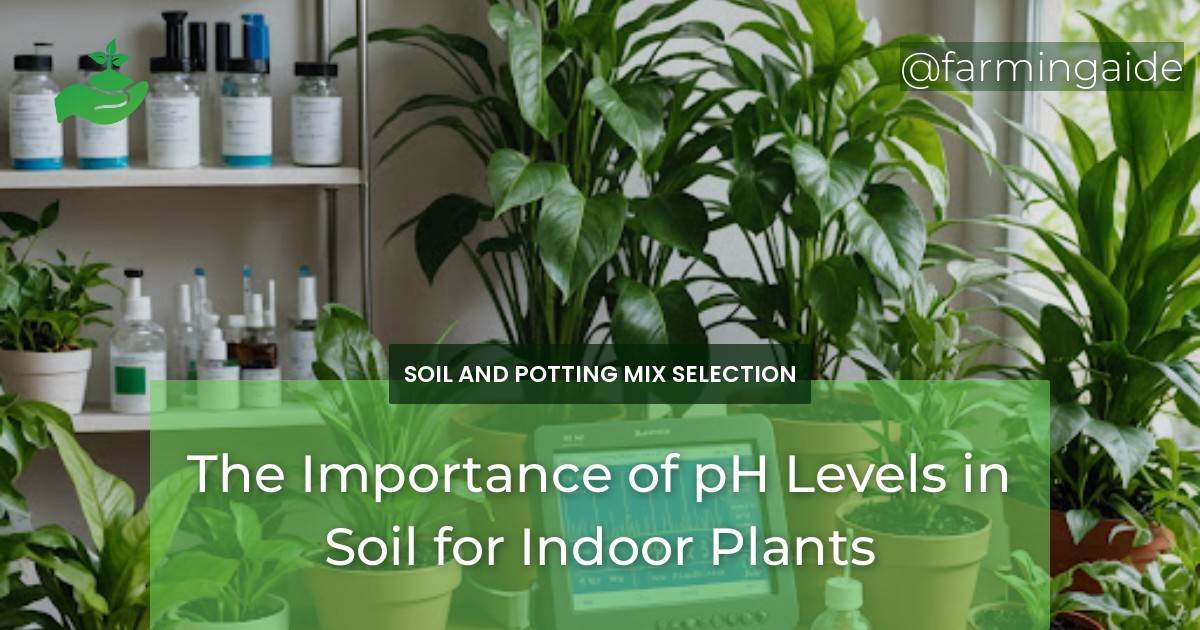When it comes to indoor plant care, many enthusiasts focus on providing their plants with sufficient light, water, and nutrients. However, one crucial aspect is often overlooked: soil pH. The pH level of your soil plays a vital role in determining the health and vitality of your indoor plants. In this article, we’ll delve into the importance of pH levels in soil for indoor plants, exploring how it affects nutrient availability, ideal pH levels for common indoor plants, and the consequences of incorrect pH levels.
Key Takeaways
- Soil pH affects nutrient availability, influencing plant growth and health.
- Ideal pH levels vary among indoor plants, with some preferring acidic, alkaline, or neutral soil.
- Incorrect pH levels can lead to nutrient deficiencies, stunted growth, and plant death.
- Regular pH monitoring and adjustments can ensure optimal soil conditions for indoor plants.
- Sustainable pH management practices can maintain healthy soil and promote plant growth.
Understanding Soil pH
Soil pH is a measure of the soil’s acidity or alkalinity, ranging from 0 to 14, with 7 being neutral. A pH below 7 is acidic, while a pH above 7 is alkaline. Most indoor plants thrive in slightly acidic to neutral soil, between pH 6.0 and 7.0.
Definition of Soil pH
Soil pH is a critical factor in plant growth, as it affects the availability of essential nutrients. A slight deviation from the ideal pH range can significantly impact plant health and productivity.
How pH Affects Nutrient Availability
Soil pH influences the solubility and availability of essential nutrients, such as nitrogen, phosphorus, and potassium. For example, nitrogen is more readily available in slightly acidic to neutral soil (pH 6.0-7.0), while phosphorus is more accessible in slightly acidic soil (pH 6.0-6.5).
Ideal pH Levels for Common Indoor Plants
While some indoor plants are more forgiving of pH fluctuations, others are more sensitive and require specific pH ranges. Understanding the ideal pH levels for your indoor plants is crucial for optimal growth and health.
ALSO READ
Acid-Loving Plants
Certain plants, such as African Violets, Ferns, and Peace Lilies, thrive in acidic soil (pH 5.5-6.5). These plants have adapted to acidic environments and may struggle in alkaline soil.
Alkaline-Loving Plants
On the other hand, plants like Succulents, Cacti, and Bromeliads prefer alkaline soil (pH 7.0-8.5). These plants have evolved to tolerate high pH levels and may suffer in acidic soil.
ALSO READ
Neutral pH Plants
Many popular indoor plants, such as Spider Plants, Dracaena, and Philodendron, thrive in neutral soil (pH 6.5-7.5). These plants are more adaptable to pH fluctuations but still benefit from optimal pH levels.
Testing and Adjusting Soil pH
Regular pH testing is essential to ensure optimal soil conditions for your indoor plants. There are several methods for testing soil pH, including:
Methods for Testing Soil pH
Commercial pH test kits, pH paper, and pH meters are available for testing soil pH. It’s essential to choose a reliable method that provides accurate results.
Adjusting pH with Amendments
If your soil pH is too high or low, amendments can help adjust the pH level. Peat moss, sulfur, and lime are common amendments used to lower or raise soil pH. However, it’s crucial to use these amendments judiciously, as over-correction can have detrimental effects on plant health.
The Impact of Incorrect pH on Plant Health
Soil pH imbalances can have devastating consequences for indoor plants, leading to:
Symptoms of pH Imbalance
Nutrient deficiencies, stunted growth, yellowing leaves, and reduced plant vigor are all symptoms of pH imbalance. If left unchecked, pH imbalances can lead to plant death.
Long-Term Effects on Plant Growth
Chronic pH imbalances can result in reduced plant growth, increased susceptibility to diseases, and a weakened root system. Plants may also become more prone to pests and require more frequent watering due to poor soil structure.
Maintaining Optimal pH for Indoor Plant Health
To ensure optimal soil pH, it’s essential to:
Regular pH Monitoring
Regularly test your soil pH to ensure it remains within the optimal range for your indoor plants.
Sustainable pH Adjustment Practices
Avoid using harsh chemicals or excessive amendments, which can disrupt soil ecology and harm plant health. Instead, opt for natural, sustainable methods to adjust soil pH, such as adding organic matter or using natural amendments like peat moss or compost.
Conclusion
In conclusion, soil pH plays a critical role in indoor plant health and growth. By understanding the ideal pH levels for your plants, testing and adjusting soil pH, and maintaining optimal pH levels, you can create a thriving environment for your indoor plants. Remember, a balanced soil pH is just one aspect of comprehensive indoor plant care, but it’s a crucial step in ensuring the health and vitality of your plants.


